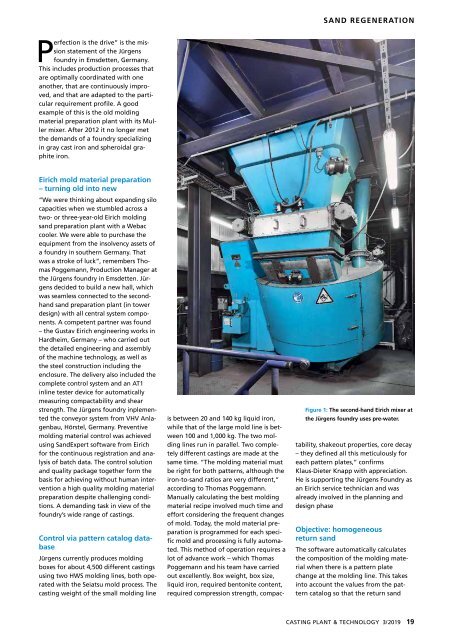Create successful ePaper yourself
Turn your PDF publications into a flip-book with our unique Google optimized e-Paper software.
SAND REGENERATION<br />
Perfection is the drive” is the mission<br />
statement of the Jürgens<br />
foundry in Emsdetten, Germany.<br />
This includes production processes that<br />
are optimally coordinated with one<br />
another, that are continuously improved,<br />
and that are adapted to the particular<br />
requirement profile. A good<br />
example of this is the old molding<br />
material preparation plant with its Muller<br />
mixer. After 2012 it no longer met<br />
the demands of a foundry specializing<br />
in gray cast iron and spheroidal graphite<br />
iron.<br />
Eirich mold material preparation<br />
– turning old into new<br />
“We were thinking about expanding silo<br />
capacities when we stumbled across a<br />
two- or three-year-old Eirich molding<br />
sand preparation plant with a Webac<br />
cooler. We were able to purchase the<br />
equipment from the insolvency assets of<br />
a foundry in southern Germany. That<br />
was a stroke of luck”, remembers Thomas<br />
Poggemann, Production Manager at<br />
the Jürgens foundry in Emsdetten. Jürgens<br />
decided to build a new hall, which<br />
was seamless connected to the secondhand<br />
sand preparation plant (in tower<br />
design) with all central system components.<br />
A competent partner was found<br />
– the Gustav Eirich engineering works in<br />
Hardheim, Germany – who carried out<br />
the detailed engineering and assembly<br />
of the machine technology, as well as<br />
the steel construction including the<br />
enclosure. The delivery also included the<br />
complete control system and an AT1<br />
inline tester device for automatically<br />
measuring compactability and shear<br />
strength. The Jürgens foundry inplemented<br />
the conveyor system from VHV Anlagenbau,<br />
Hörstel, Germany. Preventive<br />
molding material control was achieved<br />
using SandExpert software from Eirich<br />
for the continuous registration and analysis<br />
of batch data. The control solution<br />
and quality package together form the<br />
basis for achieving without human intervention<br />
a high quality molding material<br />
preparation despite challenging conditions.<br />
A demanding task in view of the<br />
foundry’s wide range of castings.<br />
Control via pattern catalog database<br />
Jürgens currently produces molding<br />
boxes for about 4,500 different castings<br />
using two HWS molding lines, both operated<br />
with the Seiatsu mold process. The<br />
casting weight of the small molding line<br />
Figure 1: The second-hand Eirich mixer at<br />
the Jürgens foundry uses pre-water.<br />
is between 20 and 140 kg liquid iron,<br />
while that of the large mold line is between<br />
100 and 1,000 kg. The two molding<br />
lines run in parallel. Two completely<br />
different castings are made at the<br />
same time. “The molding material must<br />
be right for both patterns, although the<br />
iron-to-sand ratios are very different,”<br />
according to Thomas Poggemann.<br />
Manually calculating the best molding<br />
material recipe involved much time and<br />
effort considering the frequent changes<br />
of mold. Today, the mold material preparation<br />
is programmed for each specific<br />
mold and processing is fully automated.<br />
This method of operation requires a<br />
lot of advance work – which Thomas<br />
Poggemann and his team have carried<br />
out excellently. Box weight, box size,<br />
liquid iron, required bentonite content,<br />
required compression strength, compactability,<br />
shakeout properties, core decay<br />
– they defined all this meticulously for<br />
each pattern plates,” confirms<br />
Klaus-Dieter Knapp with appreciation.<br />
He is supporting the Jürgens Foundry as<br />
an Eirich service technician and was<br />
already involved in the planning and<br />
design phase<br />
Objective: homogeneous<br />
return sand<br />
The software automatically calculates<br />
the composition of the molding material<br />
when there is a pattern plate<br />
change at the molding line. This takes<br />
into account the values from the pattern<br />
catalog so that the return sand<br />
CASTING PLANT & TECHNOLOGY 3/<strong>2019</strong> 19

















